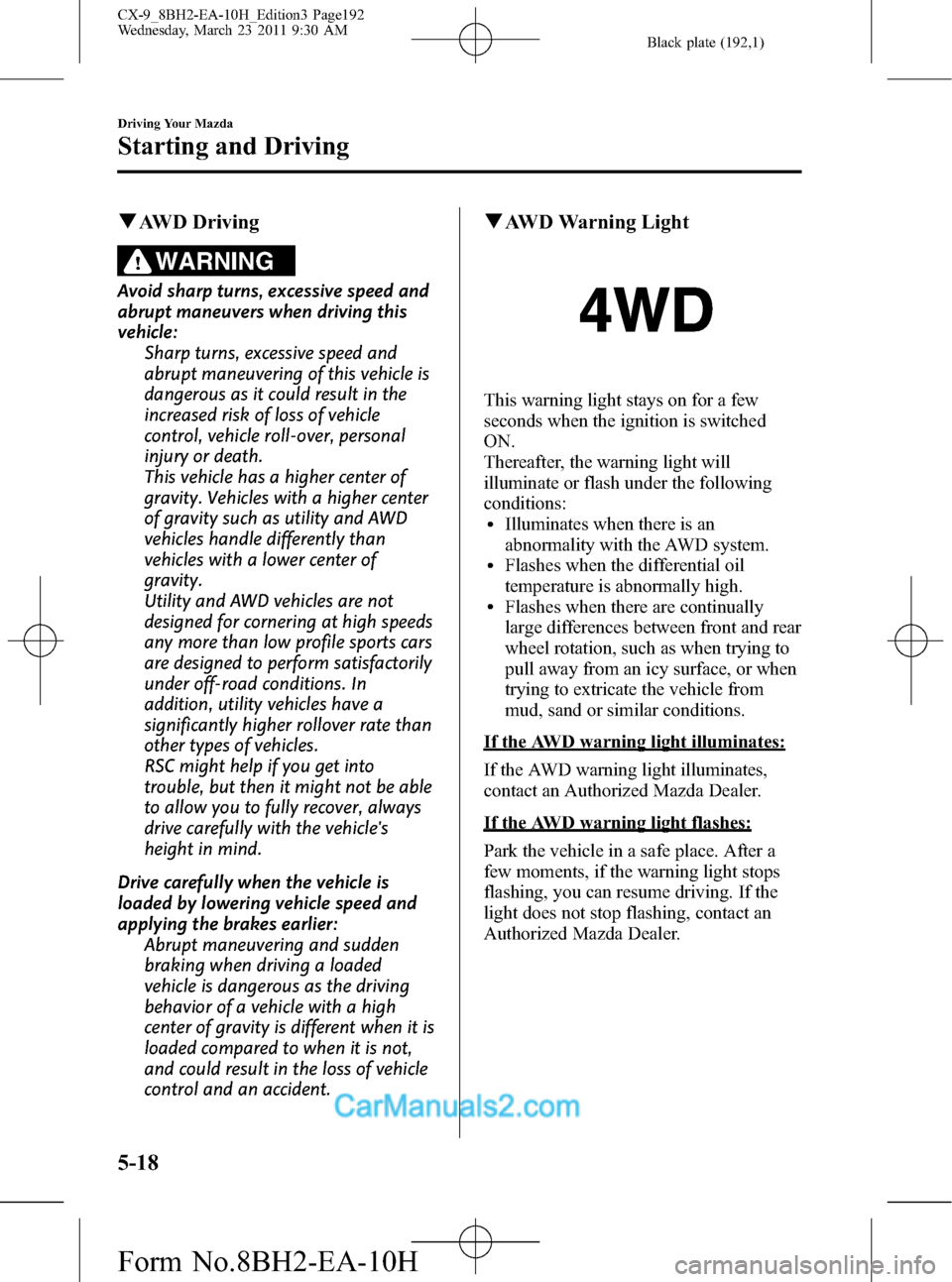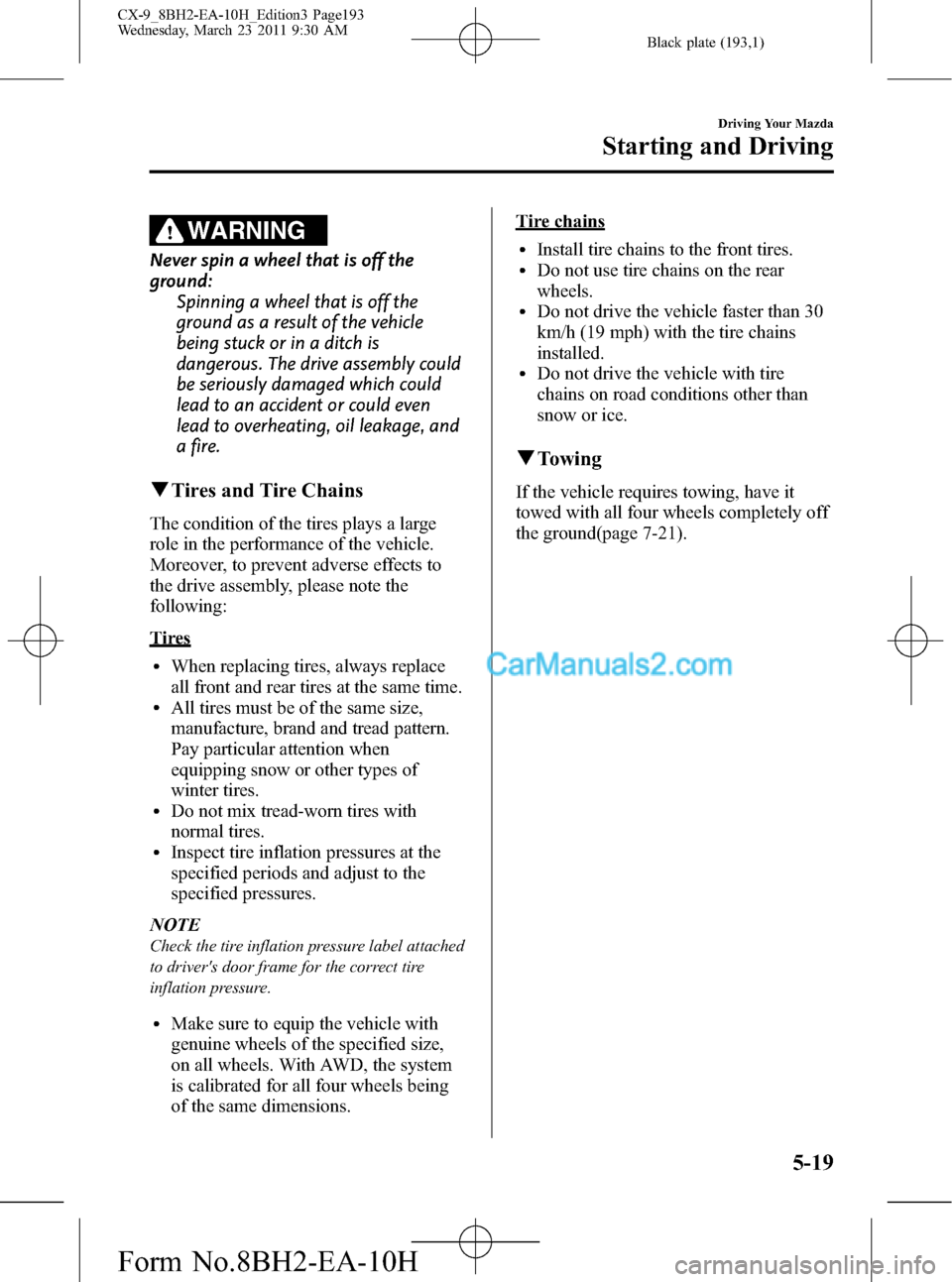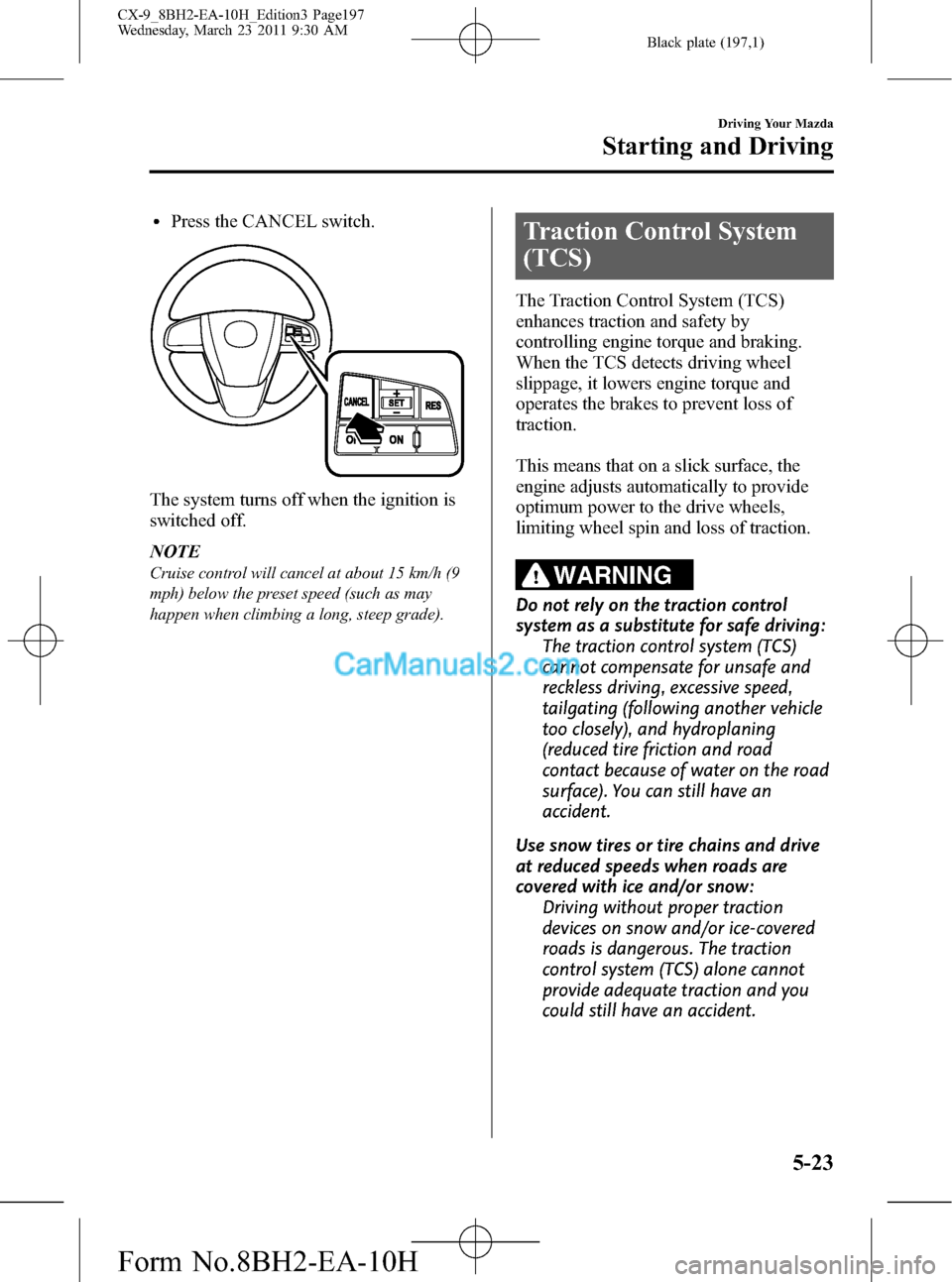MAZDA MODEL CX-9 2011 Owners Manual (in English)
Manufacturer: MAZDA, Model Year: 2011, Model line: MODEL CX-9, Model: MAZDA MODEL CX-9 2011Pages: 606, PDF Size: 13.55 MB
Page 191 of 606

Black plate (191,1)
Power Steering
Power steering is only operable when the
engine is running. If the engine is off or if
the power steering system is inoperable,
you can still steer, but it requires more
physical effort.
If the steering feels stiffer than usual
during normal driving, consult an
Authorized Mazda Dealer.
CAUTION
Never hold the steering wheel to the
extreme left or right for more than 5
seconds with the engine running.
This could damage the power
steering system.
All-Wheel Drive (AWD)
Operation
í
AWD provides excellent driveability on
snow-covered and ice-packed roads, sand
and mud, as well as on steep slopes and
other slippery surfaces.
Driving Your Mazda
Starting and Driving
5-17íSome models. CX-9_8BH2-EA-10H_Edition3 Page191
Wednesday, March 23 2011 9:30 AM
Form No.8BH2-EA-10H
Page 192 of 606

Black plate (192,1)
qAWD Driving
WARNING
Avoid sharp turns, excessive speed and
abrupt maneuvers when driving this
vehicle:
Sharp turns, excessive speed and
abrupt maneuvering of this vehicle is
dangerous as it could result in the
increased risk of loss of vehicle
control, vehicle roll-over, personal
injury or death.
This vehicle has a higher center of
gravity. Vehicles with a higher center
of gravity such as utility and AWD
vehicles handle differently than
vehicles with a lower center of
gravity.
Utility and AWD vehicles are not
designed for cornering at high speeds
any more than low profile sports cars
are designed to perform satisfactorily
under off-road conditions. In
addition, utility vehicles have a
significantly higher rollover rate than
other types of vehicles.
RSC might help if you get into
trouble, but then it might not be able
to allow you to fully recover, always
drive carefully with the vehicle's
height in mind.
Drive carefully when the vehicle is
loaded by lowering vehicle speed and
applying the brakes earlier:
Abrupt maneuvering and sudden
braking when driving a loaded
vehicle is dangerous as the driving
behavior of a vehicle with a high
center of gravity is different when it is
loaded compared to when it is not,
and could result in the loss of vehicle
control and an accident.
qAWD Warning Light
This warning light stays on for a few
seconds when the ignition is switched
ON.
Thereafter, the warning light will
illuminate or flash under the following
conditions:
lIlluminates when there is an
abnormality with the AWD system.
lFlashes when the differential oil
temperature is abnormally high.
lFlashes when there are continually
large differences between front and rear
wheel rotation, such as when trying to
pull away from an icy surface, or when
trying to extricate the vehicle from
mud, sand or similar conditions.
If the AWD warning light illuminates:
If the AWD warning light illuminates,
contact an Authorized Mazda Dealer.
If the AWD warning light flashes:
Park the vehicle in a safe place. After a
few moments, if the warning light stops
flashing, you can resume driving. If the
light does not stop flashing, contact an
Authorized Mazda Dealer.
5-18
Driving Your Mazda
Starting and Driving
CX-9_8BH2-EA-10H_Edition3 Page192
Wednesday, March 23 2011 9:30 AM
Form No.8BH2-EA-10H
Page 193 of 606

Black plate (193,1)
WARNING
Never spin a wheel that is off the
ground:
Spinning a wheel that is off the
ground as a result of the vehicle
being stuck or in a ditch is
dangerous. The drive assembly could
be seriously damaged which could
lead to an accident or could even
lead to overheating, oil leakage, and
a fire.
qTires and Tire Chains
The condition of the tires plays a large
role in the performance of the vehicle.
Moreover, to prevent adverse effects to
the drive assembly, please note the
following:
Tires
lWhen replacing tires, always replace
all front and rear tires at the same time.
lAll tires must be of the same size,
manufacture, brand and tread pattern.
Pay particular attention when
equipping snow or other types of
winter tires.
lDo not mix tread-worn tires with
normal tires.
lInspect tire inflation pressures at the
specified periods and adjust to the
specified pressures.
NOTE
Check the tire inflation pressure label attached
to driver's door frame for the correct tire
inflation pressure.
lMake sure to equip the vehicle with
genuine wheels of the specified size,
on all wheels. With AWD, the system
is calibrated for all four wheels being
of the same dimensions.
Tire chains
lInstall tire chains to the front tires.lDo not use tire chains on the rear
wheels.
lDo not drive the vehicle faster than 30
km/h (19 mph) with the tire chains
installed.
lDo not drive the vehicle with tire
chains on road conditions other than
snow or ice.
qTowing
If the vehicle requires towing, have it
towed with all four wheels completely off
the ground(page 7-21).
Driving Your Mazda
Starting and Driving
5-19
CX-9_8BH2-EA-10H_Edition3 Page193
Wednesday, March 23 2011 9:30 AM
Form No.8BH2-EA-10H
Page 194 of 606

Black plate (194,1)
Cruise Control
With cruise control, you can set and
automatically maintain any speed of more
than about 30 km/h (19 mph).
WARNING
Do not use the cruise control under the
following conditions:
Using the cruise control under the
following conditions is dangerous
and could result in loss of vehicle
control.
ØHilly terrain
ØSteep inclines
ØHeavy or unsteady traffic
ØSlippery or winding roads
ØSimilar restrictions that require
inconsistent speed
qCruise Main Indicator Light
(Amber)/Cruise Set Indicator
Light (Green)
The indicator light has two colors.
Cruise Main Indicator Light (Amber)
The indicator light illuminates amber
when the ON switch is pressed and the
cruise control system is activated.
Cruise Set Indicator Light (Green)
The indicator light illuminates green when
a cruising speed has been set.
qActivation/Deactivation
To activate the system, press the ON
switch.
The cruise main indicator light
illuminates.
To deactivate the system, press the OFF
switch.
The cruise main indicator light turns off.
WARNING
Always turn off the cruise control
system when it is not in use:
Leaving the cruise control system in
an activation-ready state while the
cruise control is not in use is
dangerous as the cruise control could
unexpectedly activate if the
activation button is accidentally
pressed, and result in loss of vehicle
control and an accident.
qTo Set Speed
1. Activate the cruise control system by
pressing the ON switch.
2. Accelerate to the desired speed, which
must be more than 30 km/h (19 mph).
5-20
Driving Your Mazda
Starting and Driving
CX-9_8BH2-EA-10H_Edition3 Page194
Wednesday, March 23 2011 9:30 AM
Form No.8BH2-EA-10H
Page 195 of 606

Black plate (195,1)
3. Set the cruise control by pressing the
cruise control SET
/SET - switch up
or down at the desired speed. The
cruise control is set at the moment the
cruise control SET
/SET - switch is
pressed up or down. Release the
accelerator pedal simultaneously.
Cruise control
switch
NOTElRelease the cruise control switch at the
desired speed, otherwise the speed will
continue increasing while the switch is
pressed up, and continue decreasing while
it is pressed down (except when the
accelerator pedal is depressed).
lOn a steep grade, the vehicle may
momentarily slow down while ascending,
or speed up while descending.
lCruise control will turn off if the vehicle
speed decreases below 30 km/h (19 mph)
when cruise is activated, such as when
climbing a steep grade.
qTo Increase Cruising Speed
Follow either of these procedures.
To increase speed using cruise control
switch
Press up the cruise control SET
switch
and hold it. Your vehicle will accelerate.
Release the switch at the speed you want.
Cruise control
switch
Your vehicle has a tap-up feature that
allows you to increase your current speed
in increments of 1.6 km/h (1 mph) by a
momentary tap of the cruise control SET
switch. Multiple taps will increase
your vehicle speed 1.6 km/h (1 mph) for
each tap.
Driving Your Mazda
Starting and Driving
5-21
CX-9_8BH2-EA-10H_Edition3 Page195
Wednesday, March 23 2011 9:30 AM
Form No.8BH2-EA-10H
Page 196 of 606

Black plate (196,1)
To increase speed using accelerator
pedal
Depress the accelerator pedal to accelerate
to the desired speed.
Press down or press up on the cruise
control SET
/SET - switch and release
it immediately.
Cruise control
switch
NOTE
Accelerate if you want to speed up temporarily
when the cruise control is on. Greater speed
will not interfere with or change the set speed.
Take your foot off the accelerator to return to
the set speed.
qTo Decrease Cruising Speed
Press down the cruise control SET -
switch and hold it. The vehicle will
gradually slow.
Release the switch at the speed you want.
Cruise control
switch
Your vehicle has a tap-down feature that
allows you to decrease your current speed
in decrements of 1.6 km/h (1 mph) by a
momentary tap of the cruise control SET -
switch. Multiple taps will decrease your
vehicle speed 1.6 km/h (1 mph) for each
tap.
qTo Resume Cruising Speed at
More Than 30 km/h (19 mph)
If some other method besides the OFF
switch was used to cancel cruising speed
(such as applying the brake pedal) and the
system is still activated, the most recent
set speed will automatically resume when
the RES switch is pressed.
If vehicle speed is below 30 km/h (19
mph), increase the vehicle speed up to 30
km/h (19 mph) or more and press the RES
switch.
qTo Cancel
To cancel the system, useoneof these
methods:
lPress the OFF switch.lSlightly depress the brake pedal.
5-22
Driving Your Mazda
Starting and Driving
CX-9_8BH2-EA-10H_Edition3 Page196
Wednesday, March 23 2011 9:30 AM
Form No.8BH2-EA-10H
Page 197 of 606

Black plate (197,1)
lPress the CANCEL switch.
The system turns off when the ignition is
switched off.
NOTE
Cruise control will cancel at about 15 km/h (9
mph) below the preset speed (such as may
happen when climbing a long, steep grade).
Traction Control System
(TCS)
The Traction Control System (TCS)
enhances traction and safety by
controlling engine torque and braking.
When the TCS detects driving wheel
slippage, it lowers engine torque and
operates the brakes to prevent loss of
traction.
This means that on a slick surface, the
engine adjusts automatically to provide
optimum power to the drive wheels,
limiting wheel spin and loss of traction.
WARNING
Do not rely on the traction control
system as a substitute for safe driving:
The traction control system (TCS)
cannot compensate for unsafe and
reckless driving, excessive speed,
tailgating (following another vehicle
too closely), and hydroplaning
(reduced tire friction and road
contact because of water on the road
surface). You can still have an
accident.
Use snow tires or tire chains and drive
at reduced speeds when roads are
covered with ice and/or snow:
Driving without proper traction
devices on snow and/or ice-covered
roads is dangerous. The traction
control system (TCS) alone cannot
provide adequate traction and you
could still have an accident.
Driving Your Mazda
Starting and Driving
5-23
CX-9_8BH2-EA-10H_Edition3 Page197
Wednesday, March 23 2011 9:30 AM
Form No.8BH2-EA-10H
Page 198 of 606

Black plate (198,1)
CAUTION
Do not rely on the TCS to maintain
constant control of the vehicle under
severe or maximum handling
conditions. If the TCS operates
frequently due to severe driving
conditions, the TCS may stop
operating to protect the brakes from
overheating. After the brakes have
cooled down, the TCS resumes
normal operation.
qTCS/DSC/RSC Indicator Light
This indicator light stays on for a few
seconds when the ignition is switched
ON. If the TCS or DSC/RSC is operating,
the indicator light flashes.
If the light stays on, the TCS, DSC/RSC
or the brake assist system may have a
malfunction and they may not operate
correctly. Take your vehicle to an
Authorized Mazda Dealer.
NOTE
lIn addition to the indicator light flashing, a
slight lugging sound will come from the
engine. This indicates that the TCS is
operating properly.
lOn slippery surfaces, such as fresh snow, it
will be impossible to achieve high rpm
when the TCS is on.
qTCS OFF Indicator Light
This indicator light stays on for a few
seconds when the ignition is switched
ON.
It also illuminates when the TCS OFF
switch is pressed and TCS is switched off.
Refer to TCS OFF Switch on page 5-25.
If the light remains illuminated and the
TCS is not switched off, take your vehicle
to an Authorized Mazda Dealer. The
dynamic stability control may have a
malfunction.
NOTE
If the TCS/DSC indicator light and the TCS
OFF indicator light remain illuminated even
after switching the ignition from ON to OFF,
and back to ON, attempt the procedure again.
If this still does not resolve the issue, consult
an Authorized Mazda Dealer.
5-24
Driving Your Mazda
Starting and Driving
CX-9_8BH2-EA-10H_Edition3 Page198
Wednesday, March 23 2011 9:30 AM
Form No.8BH2-EA-10H
Page 199 of 606

Black plate (199,1)
qTCS OFF Switch
If the vehicle speed is less than 15 km/h
(9 mph), press the TCS OFF switch to
turn off the TCS. The TCS OFF indicator
light will illuminate.
Press the switch again to turn the TCS
back on. The TCS OFF indicator light
will turn off. If the vehicle speed is more
than 15 km/h (9 mph), the TCS OFF
indicator light will not illuminate even if
the switch is pressed.NOTE
lWhen TCS is on and you attempt to free the
vehicle when it is stuck, or drive it out of
freshly fallen snow, the TCS will activate.
Depressing the accelerator will not
increase engine power and freeing the
vehicle may be difficult. When this happens,
turn off the TCS.
lIf the TCS is off when the engine is turned
off, it automatically activates when the
ignition is switched ON.
lLeaving the TCS on will provide the best
traction.
lIf the TCS is OFF when the vehicle speed is
more than 15 km/h (9 mph), it
automatically activates and the TCS OFF
indicator light will turn off.
lIf the TCS OFF switch is pressed and held
for 10 seconds or more, the TCS OFF
switch malfunction detection function
operates and the TCS and DSC/RSC system
activates automatically. The TCS OFF
indicator light turns off while the TCS
system is operative.
Driving Your Mazda
Starting and Driving
5-25
CX-9_8BH2-EA-10H_Edition3 Page199
Wednesday, March 23 2011 9:30 AM
Form No.8BH2-EA-10H
Page 200 of 606

Black plate (200,1)
Dynamic Stability Control
(DSC)/Roll Stability
Control (RSC)
The Dynamic Stability Control (DSC)
automatically controls braking and engine
torque in conjunction with systems such
as ABS and TCS to help control side slip
when driving on slippery surfaces or
during sudden or evasive maneuvering,
enhancing vehicle safety.
The Roll Stability Control (RSC)
automatically controls braking and engine
torque in conjunction with systems such
as ABS and TCS to help control rolling
when cornering at a higher speed or
during sudden or evasive maneuvering,
enhancing vehicle safety.
Refer to ABS (page 5-8) and TCS (page
5-23).
DSC/RSC operation is possible at speeds
greater than 15 km/h (9 mph).
WARNING
Do not rely on the dynamic stability
control as a substitute for safe driving:
The dynamic stability control (DSC)/
Roll Stability Control (RSC) cannot
compensate for unsafe and reckless
driving, excessive speed, tailgating
(following another vehicle too
closely), and hydroplaning (reduced
tire friction and road contact because
of water on the road surface). You
can still have an accident.
When driving under bad road
conditions, lower the vehicle speed and
drive carefully:
Reckless driving and excessive speed
under any road conditions is
dangerous as it reduces vehicle
stability and operability which could
result in an accident.
5-26
Driving Your Mazda
Starting and Driving
CX-9_8BH2-EA-10H_Edition3 Page200
Wednesday, March 23 2011 9:30 AM
Form No.8BH2-EA-10H